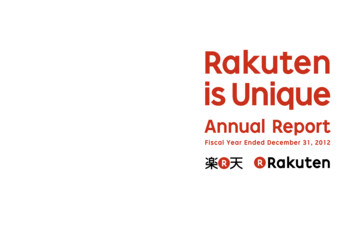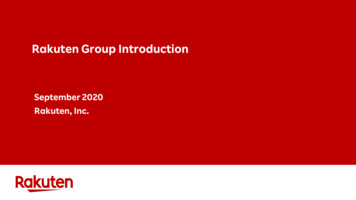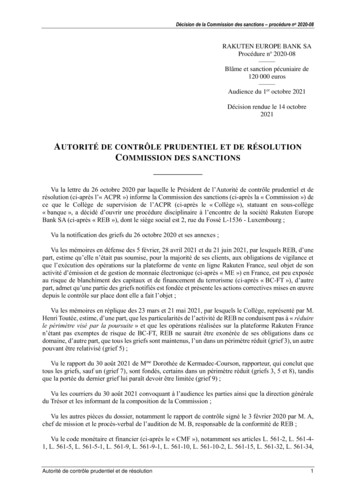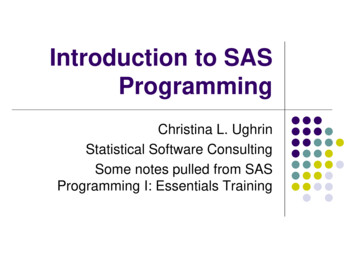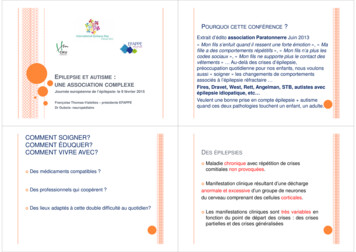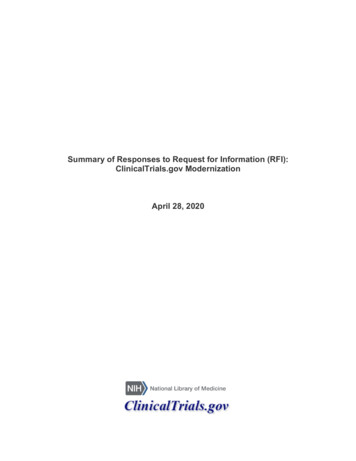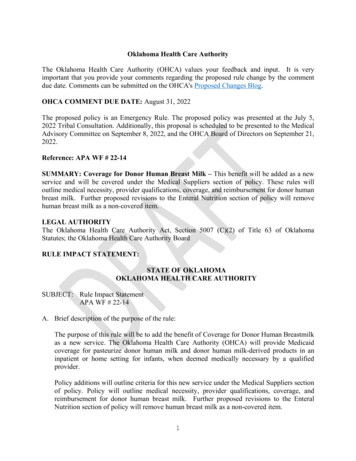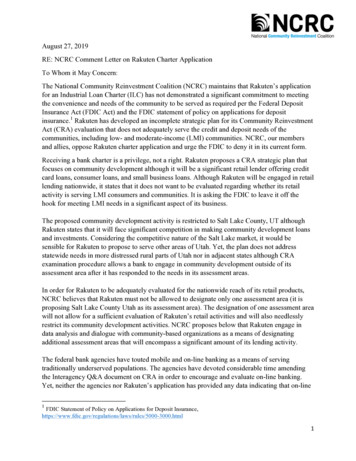
Transcription
August 27, 2019RE: NCRC Comment Letter on Rakuten Charter ApplicationTo Whom it May Concern:The National Community Reinvestment Coalition (NCRC) maintains that Rakuten’s applicationfor an Industrial Loan Charter (ILC) has not demonstrated a significant commitment to meetingthe convenience and needs of the community to be served as required per the Federal DepositInsurance Act (FDIC Act) and the FDIC statement of policy on applications for depositinsurance.1 Rakuten has developed an incomplete strategic plan for its Community ReinvestmentAct (CRA) evaluation that does not adequately serve the credit and deposit needs of thecommunities, including low- and moderate-income (LMI) communities. NCRC, our membersand allies, oppose Rakuten charter application and urge the FDIC to deny it in its current form.Receiving a bank charter is a privilege, not a right. Rakuten proposes a CRA strategic plan thatfocuses on community development although it will be a significant retail lender offering creditcard loans, consumer loans, and small business loans. Although Rakuten will be engaged in retaillending nationwide, it states that it does not want to be evaluated regarding whether its retailactivity is serving LMI consumers and communities. It is asking the FDIC to leave it off thehook for meeting LMI needs in a significant aspect of its business.The proposed community development activity is restricted to Salt Lake County, UT althoughRakuten states that it will face significant competition in making community development loansand investments. Considering the competitive nature of the Salt Lake market, it would besensible for Rakuten to propose to serve other areas of Utah. Yet, the plan does not addressstatewide needs in more distressed rural parts of Utah nor in adjacent states although CRAexamination procedure allows a bank to engage in community development outside of itsassessment area after it has responded to the needs in its assessment areas.In order for Rakuten to be adequately evaluated for the nationwide reach of its retail products,NCRC believes that Rakuten must not be allowed to designate only one assessment area (it isproposing Salt Lake County Utah as its assessment area). The designation of one assessment areawill not allow for a sufficient evaluation of Rakuten’s retail activities and will also needlesslyrestrict its community development activities. NCRC proposes below that Rakuten engage indata analysis and dialogue with community-based organizations as a means of designatingadditional assessment areas that will encompass a significant amount of its lending activity.The federal bank agencies have touted mobile and on-line banking as a means of servingtraditionally underserved populations. The agencies have devoted considerable time amendingthe Interagency Q&A document on CRA in order to encourage and evaluate on-line banking.Yet, neither the agencies nor Rakuten’s application has provided any data indicating that on-line1FDIC Statement of Policy on Applications for Deposit les/5000-3000.html1
and mobile banking is effectively serving low- and moderate-income (LMI) populations. If theFDIC does not require a rigorous CRA strategic plan from Rakuten with specific goals forserving consumers and small businesses with deposit accounts, credit card loans or consumerloans, an approval of an inadequate plan will merely exacerbate the digital divide and encouragemore fintechs to apply for bank charters without any ironclad plans for serving LMIcommunities. In addition, the community development service portion of Rakuten’s strategicplan is poorly developed. It does not address how Rakuten, an internet provider of access toshopping and banking services, could provide financial education designed to help LMI peopleaccess responsible shopping and banking services.The FDIC’s statement of policy on applications for deposit insurance states that a factor forconsideration of approval of a charter application is the “willingness and ability of the applicantto serve those financial needs (credit and deposit needs).”2 While Rakuten acknowledges CRAobligations, its CRA strategic plan falls short of demonstrating a commitment to adhere toCRA’s obligations commensurate with Rakuten’s ability.In addition, NCRC is opposed to ILC charters as problematic from a safety and soundnessperspective. ILC charters can include a parent institution that is not a financial institution.Federal agencies cannot comprehensively examine the parent nor other affiliates and subsidiariesfor their safety and soundness. The ability of the FDIC to monitor thoroughly the relationshipbetween the ILC and its parent and to monitor risk the parent poses to the ILC has beenquestioned by the Government Accountability Office and other stakeholders. These concerns aremagnified in the case of Rakuten since its application says it owns 43 companies in the UnitedStates alone.3 What is the financial condition of these companies? Should any of them becomeimperiled financially, what demands will Rakuten’s parent place on the proposed ILC to bail outthe troubled companies?During the financial crisis, two ILCs, Security Savings Bank, based in Nevada, and AdvantaBank Corp, based in Utah failed. In addition, a number of parents of ILCs, including LehmanBrothers, General Motors, Flying J Inc., Capmark Financial Group Inc., CIT Group Inc., andResidential Capital, LLC filed for bankruptcy.4In contrast to Rakuten’s CRA plan, NCRC believes the FDIC should consider the following asminimal requirements for an online lender applicant creating a rigorous CRA plan. Such a planmust be comprehensive, qualities lacking in Rakuten’s proposed plan:Affiliates and Subsidiaries Must be Included2FDIC Statement of Policy.Rakuten’s application, p. 2.4Statement of Martin J. Gruenberg, Chairman, Federal Deposit Insurance Corporation on De Novo Banks andIndustrial Loan Companies before the Committee on Oversight and Government Reform; U.S. House ofRepresentatives; 2157 Rayburn House Office Building, html32
Rakuten says one affiliate located in San Mateo, California could be included in its CRAstrategic plan and serve as a launching pad for community development activities in the SanMateo area. NCRC is pleased that Rakuten is considering this but maintains that all U.S.-basedaffiliates must be automatically included in the strategic plan. Affiliate locations should bedesignated assessment areas since Rakuten’s employees of the affiliates could contribute to thedevelopment and execution of CRA activities. Excluding affiliates reduces the amount ofresources available for CRA activities. Also, Rakuten’s fair lending and consumer compliancereviews, which are conducted concurrently with CRA exams, would not consider affiliateactivity nor would sanction Rakuten due to any illegal or abusive practices of the affiliates.Assessment Area Cannot be Narrow but Must Include Areas Where a Substantial Amountof Business is ConductedRakuten’s strategic plan establishes Salt Lake County, Utah as the assessment area for Rakutenbecause the bank’s headquarters is located in the county.5 This narrow assessment area is nottruly responding to credit and deposit needs where Rakuten is doing business and will thus fallshort of meeting the convenience and needs requirement for a charter application.It is a contradiction in terms for a branchless fintech to establish its assessment area where itsheadquarters is. In this case, Rakuten is acting as if its headquarters location is a branch and assuch, the headquarters location will make loans in its contiguous community. But theheadquarters is not a branch and will not be used for making loans. This sleight of hand mocksthe intention of CRA to serve credit needs wherever a lender is conducting business.Rakuten clearly states that it will be a nationwide lender in the following:Rakuten Bank America will provide the following products and services: consumer loans,consumer credit cards, consumer deposits (NOW, savings, and time), merchant acquiring,commercial loans, and commercial savings accounts. This simple, yet profitable productsuite was selected to specifically serve the users of the U.S.-based online marketplace,both consumers and merchants. These offerings will essentially complete the RakutenU.S. ecosystem, whereby consumers and merchants are served in a common onlinemarketplace that creates loyalty and provides real value to both sets of customers.6The CRA regulations do not prohibit a branchless bank from establishing assessment areasbeyond its headquarters. Assessment areas can include areas where substantial amounts oflending activity occur.7 Again, if Rakuten’s assessment area is restricted to Salt Lake City, Utah,Rakuten is not demonstrating a willingness to serve credit and deposit needs where it doesbusiness as required by the FDIC statement of policy.5Rakuten application, p. 6.Rakuten application, p. 3.7See § 345.41 (c) (2), Assessment area delineation, of the FDIC CRA regulation 0-6500.html#fdic2000part345.4163
Using loan data, NCRC believes that the agencies can require non-traditional banks and fintechsto create assessment areas that capture the vast majority of their loans. An example of lending bystate for Lending Club during the time period of 2012 and 2013 shows that assessment areas canbe meaningfully created for an on-line lender (a two year time period is a typical time periodcovered by a CRA exam).8 Lending Club makes data on its lending activity by state and for threedigit zip codes publicly available, a practice NCRC recommends for Rakuten.Several states have sizable numbers of Lending Club loans in this time period even beforeLending Club’s substantial lending increases of more recent years. During 2012 and 2013,Lending Club made more than 188,000 loans; most of these were consumer-related loans and/orrefinancing and consolidation of outstanding debt (see table below). Another table below onlending by state reveals that heavily populated states including California, New York, Texas andFlorida had the highest percentage of loans. Ten states each had more than 3 percent of LendingClub’s loans.9 On the other end of the scale, 28 states each had less than 1.5 percent of LendingClub’s loans. In sum, it is quite feasible for at least the top ten or twenty states to constituteassessment areas; these states had high numbers of loans and reasonably high percentages ofLending Club’s loans.To further investigate how assessment areas would work for a non-traditional bank, NCRCtabulated loans by three digit zip code and metropolitan areas for Texas, one of Lending Club’shigh volume states. We found five metropolitan areas with more than 1,000 loans each and onearea, North Texas that could possibly be considered a rural area. The five metropolitan areasrange in size and location across the state and include Houston, Austin, Ft. Worth, Dallas, andSan Antonio. El Paso is the seventh largest area by loan volume with more than 500 loans. UsingLending Club as an example, designating metropolitan areas and counties as assessment areas fornon-traditional lenders is feasible and can include a diversity of areas.Rakuten should make a commitment similar to Lending Club’s of sharing the location of itsconsumer, small business, and credit card lending by state, metropolitan area, and county. Itcould also provide geographical data on its deposit taking activity. Rakuten should then conferwith community-based organizations and other stakeholders in deciding which geographicalareas will constitute assessment areas. Assessment areas should capture the majority of its retailactivity and include a healthy mix of states, metropolitan areas, and rural counties. SinceRakuten would be a de novo bank, NCRC would be receptive to a procedure in which Rakutenadds assessment areas during each of its three years of its strategic plans so it can developinfrastructure and partnerships with community-based organizations for helping it achieve goalsand targets across its assessment areas.NCRC believes that assessment areas for fintechs must include rural areas. Populations in ruralareas are less likely to be connected to the internet. While only 4 percent of people living in89See https://www.lendingclub.com/info/statistics.action for summary data tables and to download data.These states are CA, NY, TX, FL, IL, NJ, PA, OH, GA,VA.4
urban areas lack adequate broadband services, this issue is particularly concentrated in ruralareas and tribal lands, with 39 percent and 41 percent respectively, still lacking access.10 Iffintechs do not make efforts to serve rural areas, the digital divide disadvantaging ruralcommunities will only widen.Lending Club Loans 2012-2013state 1,6830.9%UT1,4820.8%AR1,4210.8%102016 Broadband Progress Report, Federal Communications Commission, Jan. 29, 2016, retrieved port5
81Purpose# LoansCar1,9511.0%Credit ,45159.2%10,2975.5%Medical1,5190.8%Small 81Texas Zip Codes770, 72, 73, 74, 75 Houston750 North Texas760, 61, 62, 64 Ft. Worth, TXPercent# Loans3,6342,0741,836Percent25.0%14.3%12.6%6
786, 87, 89 Austin, TX751, 52, 53 Dallas780, 81, 82, 88 San Antonio TX798, 99 El Paso, TX765, 66, 67 Waco, TX785 McAllen TX756, 57 East Texas793, 94 Lubbock, TX790, 91 Amarillo, TX769, 97 Midland, TX754 Greenville TX783, 84 Corpus Christi768, 78 Bryan, TX776, 77 Beaumont, TX795, 96 Abilene, TX759 Lufkin, TX763 Wichita Falls TX755 Texarkana779 Victoria, TX758 Palestine, TX792 Childress, %0.3%0.1%100.0%Three digit zip codes, some metro areas had more than one zip code, some zip codes are abbreviatedsee 7/print/L002.htmTowards a Substantial CRA Plan that Utilizes the Talents and Expertise of the ApplyingInstitutionA non-bank applying for a bank charter must apply its talent and expertise in serving the LMIpopulation. Rakuten’s major line of business is operating as a shopper’s network and offeringconsumer and credit card loans. Yet, its major commitment in its CRA plan consists ofcommunity development lending and investing in Salt Lake County. It will also engage inunspecified amount of financial education in its assessment area in the county. Rakuten is notsubstantially using its “ability” to meeting credit needs as required by the FDIC Statement ofPolicy.NCRC believes that Rakuten’s strategic plan must be re-cast. Rakuten must not be allowed toonly engage in community development financing and services. The first part of the strategicplan regulation emphasizes lending and lending-related activities if appropriate considering aninstitution’s capacity and business model as Rakuten itself acknowledges. Accordingly, thestrategic plan must include the following for Rakuten’s retail operations:Measurable Goals7
A CRA plan must have measurable goals so that the public can judge the extent of concretebenefits for the LMI community. Commitments to provide loan or bank deposit products withoutmeasurable goals can result in a lending institution declaring that a minimal number of productsfor LMI populations over the CRA plan time period meets the requirements of the CRA plan.Measurable goals prevent “gaming” and declaring fulfillment of CRA obligations with minimalefforts. In addition, measurable goals provide a substantive opportunity for the public tocomment on the adequacy of the CRA plan.Since Rakuten will likely have sizable retail operations, NCRC believes that goals for retaillending are needed and realistic. Celtic Bank, one of the peers Rakuten lists in its application, hasa strategic plan that includes measurable goals such as percent of loans to small business in LMItracts and to small businesses with revenues under 1 million.11Consumer and Credit Card LendingRakuten does not provide information on the volume of its credit card or consumer installmentlending but its global internet presence suggests that it is likely a high volume retail serviceprovider. It has the resources, expertise, and capacity to develop responsible credit card andconsumer loan products for LMI consumers and communities. Recently, Robinhood, a fintechbrokerage company, applied to the OCC for a bank charter and committed to providing a securedcredit card to LMI customers. NCRC commented that Robinhood’s plans were inadequatebecause an expensive secured credit card was the only product it was proposing to offer LMIcustomers. However, Rakuten’s plans are even worse because it will not commit to using itsretail operations to serving LMI customers.NCRC believes that Rakuten should develop a suite of retail products for LMI customers andcommunities. A secured credit card to help LMI borrowers build credit can be part of the suitebut only if Rakuten provides a clear ladder for helping LMI borrowers graduate from securedcredit cards and then use lower cost credit cards after they have demonstrated a good paymentrecord. In addition, the consumer lending can include a product that helps consumers affordsudden expenses. This would address a glaring need since Federal Reserve surveys indicate thatmost consumers in the United States cannot afford an emergency expense of 400 or more.12Rakuten could also help LMI customers find stores on its shoppers network such as applianceproviders that offer affordable deals to replace broken items.Rakuten should develop goals such as percent of credit card and consumer loans to LMIborrowers as part of its strategic plan. It should collect data on the number and percent of itsborrowers that are LMI. The GAO recently reported that about a quarter of CRA exams includeevaluations of consumer lending.13 The exams include comparisons of the percent of consumer11CRA exam of Celtic Bank, https://www5.fdic.gov/CRAPES/2017/57056 171106.PDFBoard of Governors of the Federal Reserve System, Report on the Economic Well Being of U.S. Households in2017, May 2018, p. 21, 5.pdf13Government Accountability Office: Community Reinvestment Act: Options for Treasury to Consider toEncourage Services and Small-Dollar Loans When Reviewing Framework, March 16, 2018,https://www.gao.gov/products/GAO-18-244128
loans to the percent of assessment area populations that are LMI. Rakuten should consult withthese exams to further develop their goals for credit card and consumer lending.Rakuten touts its rewards program for consumers in the form of discounts and cash back inreturn for purchasing consumer items via its website.14 If Rakuten wants to make a concertedeffort to serve LMI customers, it could tailor some of its discount offerings to this population.Perhaps it could offer larger discounts for basic necessities such as appliances or perhaps it coulddevelop a progressive discount structure that offers larger discounts for LMI consumers. Adiscount system structured in this manner could attract LMI customers. Rakuten could then askthem if they would be interested in any of Rakuten credit or deposit products.Rakuten says that most of its customers are not in its assessment area or are LMI, so that’s why itwill not develop a retail portion of its strategic plan.15 This seems to be just too convenient andan excuse to evade CRA responsibilities. Above, NCRC offers sensible suggestions fordeveloping additional assessment areas and serving LMI customers.Small Business LendingRakuten mentions it offers commercial loans, savings accounts, and merchant lines of credit butthen later in its application states that it has limited retail operations.16 NCRC wonders whetherRakuten, as a global service providers, “protests” too much regarding the limited nature of itsretail operations. Presumably, Rakuten has established several business relationships with anumber of merchants of all sizes. It would follow logically that this is how it generates itscommercial banking business. How many of these merchants are small businesses and how manyof them are located in LMI census tracts? A strategic plan that fails to discuss how an aspect ofits retail operations could be tailored to help underserved businesses must not be approved.If the retail operations are limited, the public has a right to review verifiable data regarding lowvolume lending and offer its opinions as to whether programs could still nevertheless bedeveloped to help the smallest businesses in Rakuten’s network obtain access to credit andcapital. On the other hand, if the commercial lending and savings operations are at highervolumes, goals in terms of the number and percent of loans to small businesses and in LMI tractsare feasible and should be developed.Deposit Accounts and Service DeliveryFor its mobile banking, Rakuten should adopt benchmarks based on specific guidance on howCRA examiners evaluate alternative delivery systems in the Interagency Questions and Answers14Rakuten application, p. 13.Rakuten application, p. 60.16Rakuten application, p. 3 and 60 for discussion of its commercial products, and p. 41; its strategic plan states it haslimited retail operations.159
Regarding CRA (Interagency Q&A).17 The Interagency Q&A advises that CRA examiners willscrutinize whether a financial institution’s alternative delivery systems are effectively deliveringservices to LMI populations by considering a variety of factors including: ease of access; cost toconsumers; range of services delivered; ease of use; rate of adoption and use; and reliability ofthe system.18 Rakuten should establish specific performance measures and goals for the LMIcommunity for each of these factors. Factors like the rate of adoption and use and the reliabilityof the system should have separate metrics and goals specifically set for rural as well as urbanareas, and for under banked populations. The federal bank agencies have an opportunity to useits recent Q&A guidance and insist that Rakuten’s CRA plan incorporate these metrics so thatthe public can discern whether Rakuten’s charter application would specifically meet theconvenience and needs of LMI communities.Financial EducationNCRC finds the community development service portion of the strategic plan to be sorelywanting and not responsive to community needs. It only offers vague indications of whatactivities Rakuten will provide where. The application states, “The Bank’s CEO and otherofficers have taught financial literacy classes in schools and other programs in the past and willactively seek out ways to provide such services in the AA through the schools, and nonprofitprograms.”19 “Once the Bank has adequately addressed the needs within its AA, communitydevelopment service hours outside the AA will be considered.”20 It is hard for the public to judgethe quality of the planned community development services when the public does not have eitherbasic or detailed descriptions of what they are. Moreover, the public does not know if they willbe targeted to particularly underserved places or people.An internet-based bank that specializes in on-line provision of financial products should tailor acommunity development service program that focuses on increasing access to responsible mobilebank products and services. Instead, Rakuten’s draft strategic plan merely lists the number ofcommunity development service hours that will be performed annually during each of the threeyears. Each employee will commit up to six hours. In year one, a goal of 300 hours implies thatRakuten’s bank will have 50 U.S.-based employees. By year three, the goal of 400 hours impliesthat the number of employees will grow to about 66.21 The goals in terms of hours does notindicate any comprehensive or strategic approach to delivering financial education in terms ofhelping the un- or under-banked access mobile banking. Instead, the goals in terms of hourssuggests an ad hoc and helter-skelter approach in which each employee will engage in activities,some of which will only be vaguely associated with the regulatory definition of communitydevelopment.17Community Reinvestment Act; Interagency Questions and Answers Regarding Community Reinvestment ActGuidance, OCC, Board of Governors of the Federal Reserve System, FDIC, Fed. Reg. 81, 142 at pdf/2016-16693.pdf18Interagency Q&A at 48542.19Rakuten application, p. 66.20Rakuten application, p. 69.21Rakuten application, p. 69.10
NCRC expects a well-thought out plan of how Rakuten will be delivering financial educationacross its business footprint in additional assessment areas in urban and rural areas (chosen in amanner suggested above) and not just in Salt Lake County, Utah. Rakuten could use the FDIC’sstudy of the under- and un-banked (which it cities in its application) for identifying areas in itsfootprint that would be targeted for community development services because they have highpercentages of these populations. The plan would either identify nonprofit or public sectorpartners for financial education activities. The strategic plan identifies schools as a possibility,which would be a valuable partner. The partners could offer Rakuten webinars and/or deliver thefinancial education in person, using both their own and Rakuten staff. NCRC would rather havefewer Rakuten staff devoting a greater percentage of time to a well thought out plan than all staffpursuing ad hoc activities, which will likely not have significant impact.In addition to hours of financial education counseling, NCRC wants to see outcomemeasurements. How many classes will the hours commitments produce? How many LMI clientswill be served? How many of the clients will have improvements in their accounting, creditscores, ability to secure loans, and other objective measures of achievement. How many accountswere opened? How much did participants save? How much did participants pay down debts? It isnot enough to simply list staffing hours. There must be a commitment to a thoughtful program offinancial education and coaching that produces measurable improvements for the clients. EitherRakuten can develop these outcomes measurements based on its own experience deliveringcounseling or based on the experience of its nonprofit partners.Community Development Lending and Investments Priorities for Salt Lake CountyRakuten describes community and credit needs for Salt Lake County in detail over several pagesof its strategic plan but then offers vague plans for addressing them. Rakuten also seeks toestablish low expectations of its community development activities in the Salt Lake City area,citing vigorous competition from the 42 banks located there for community development.22Over a number of pages, Rakuten describes an affordable housing shortage and vigorous jobgrowth but also wages that have not kept up with housing costs. Prices are high for prospectivehomeowners while renters, particularly lower income renters, also confront high housing costs.23From Rakuten’s analysis, it seems for lower income people, there is a mismatch in terms of jobswith livable wages and the jobs they hold. Rakuten further mentions expansion of the airport,which would offer the prospect of a number of new jobs.24 Rakuten also mentions that about18% of the population of Salt Lake County are Hispanic.25 Finally, Rakuten mentions aninteragency forum in 2015 in which affordable housing, job training, and small businessfinancing where identified as pressing needs.2622Rakuten application, p. 55 and page 61.Rakuten application, p. 45 for high price of homes, page 46 for high rental costs and low vacancies.24Rakuten application, p. 4925Rakuten application, p. 5026Rakuten application, p. 53.2311
The application describes innovative housing and small business programs. For example, itmentions a venture capital program for small businesses operated by the University of Utah.27 Italso mentions the needs of Native American populations.Despite the description of all these needs and programs to address them, Rakuten seems to thenoffer modest responses, noting the competition of established banks for community developmentfinancing. For example, for affordable housing, Rakuten mentions it will purchase Ginnie MaeSecurities.28 This a secondary market activity that is generally considered only modestlyresponsive to needs and not particularly innovative by CRA examiners. Although Salt LakeCounty has a high number of banks, it would seem that the housing developers listed in theapplication would still have needs such as lines of credit or public sector programs such as lowdownpayment programs would need additional sources of financing. Moreover, Rakuten shouldexplore job development and small business creation activities associated with the airportexpansion and with institutions such as the University of Utah. Finally, how are the needs of thesizable Hispanic population being met in terms of job creation, housing, and financial education?Rakuten mentions lines of credit and Low Income Housing Tax Credits in terms of af
Rakuten clearly states that it will be a nationwide lender in the following: Rakuten Bank America will provide the following products and services: consumer loans, consumer credit cards, consumer deposits (NOW, savings, and time), merchant acquiring, commercial loans, and commercial savings accounts. This simple, yet profitable product
